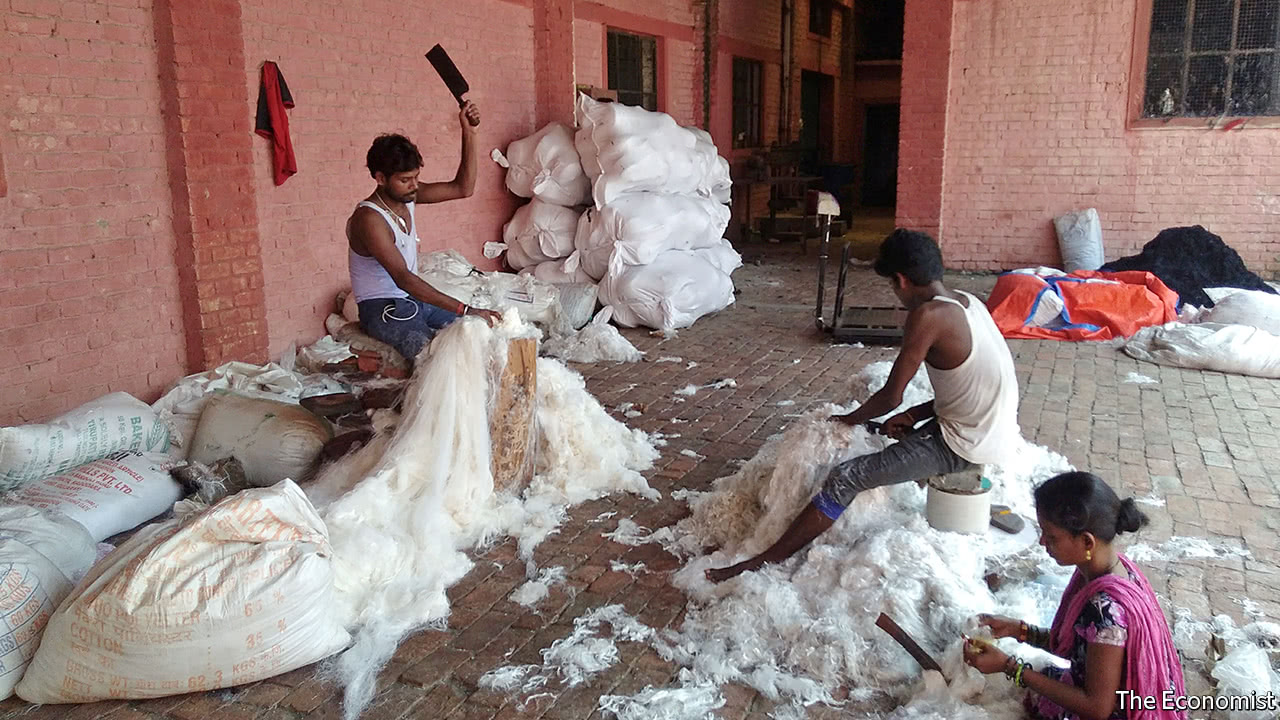
WHEN the doors open to the warehouse at Ambey Spinning Mills in Panipat, a city 90km from Delhi, it seems as if its contents might tumble out like those of an overstuffed cupboard. Heaps of clothes are piled to the ceiling. Ten women meticulously extract zips, chains and buttons from T-shirts, winter jackets and denims using long blades usually used to chop vegetables. Outside, a teenage boy wields a knife to bash synthetic fibre against a tree stump. In another workshop clothes are shredded, spun into yarn and woven by power looms into blankets. Bullock carts take them for further processing; they are then sent off for sale in India and beyond.
Known as the “cast-off capital”, Panipat is home to 150-200 such mills, which take in discarded clothes from Western countries and turn them into recycled cloth. The industry employs around 20,000 people and brings in annual revenues of $62m, according to Pawan Garg of All India Woollen and Shoddy Mills Association, a trade body (“shoddy” was originally a non-pejorative word for reclaimed fibre).
-
Why Stephen King’s novels still resonate
-
Are Americans sacrificing food and clothing to pay their taxes?
-
Retail sales, producer prices, wages and exchange rates
-
Foreign reserves
-
Why “affordable housing” in Africa is rarely affordable
-
What effect is Donald Trump really having on American tourism?
Panipat’s history in textiles began after the Indian subcontinent’s bloody partition in 1947, when weavers from the province of Sindh and the districts of Jhang and Multan in Punjab, finding themselves suddenly located in Pakistan, were uprooted and moved to the ancient city. They set up looms to knit coarse, hand-spun cotton carpets, wall hangings and sofa covers (from new wool) that were an instant hit abroad (and qualified as a dowry in marriages in northern India). The city’s later emergence as a recycling hub coincided with a slump in Prato, a small industrial town in Italy with a 1,000-year-old tradition in textiles. In the 1990s Panipat mill owners bought discarded Italian machinery from Prato designed to make cheap shoddy yarn from recycled wool. The industry took off; its annual revenues rose to over $300m.
Times have since changed. Cheaper and lighter polyester substitutes are increasingly preferred by wholesale buyers such as aid agencies, railways and hospitals, whether Indian or foreign. Such materials need expensive machines that many Panipat mills cannot afford. Rising labour costs have squeezed margins. An erratic electricity supply and frequent machinery breakdowns are more of a scourge than ever. Indian winters are shorter, complains one mill owner, which affects domestic demand for woollen clothing. Most factories in Panipat are working at half capacity.
The business is fragmented, poorly organised and almost wholly unregulated. Had there been basic oversight by the government, some in the business say, standards might have risen. Whatever the reasons, the mills did not invest much of their formerly fat profits into upgrading machinery or workers’ skills. That could have helped them find more customers willing to pay a premium for high-quality fabric from recycled yarn, which appeals to environmentally conscious companies.
Panipat may help the planet but also exhibits the least attractive features of the textile business in developing countries: sweatshop conditions for workers, rock-bottom pay, use of child labour and so on. Almost all workers there are contract labourers who earn a tenth of what those in the formal sector are paid. Women receive 120 rupees ($1.80) a day for manually ripping up around 100kg of garments. Workers manage to sell off baubles and trinkets scavenged from the cast-off clothes but must often share the proceeds with mill owners. Despite the bosses’ attention to such details, “there is no money in it anymore,” says Mr Garg.
Source: economist
Panipat, the global centre for recycling textiles, is fading